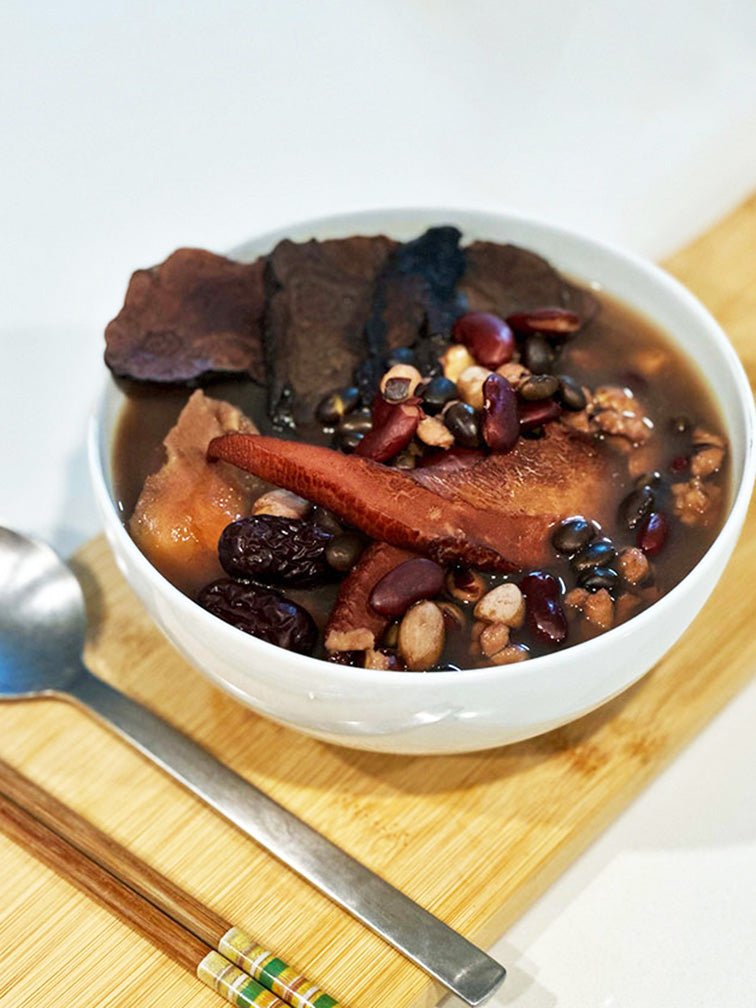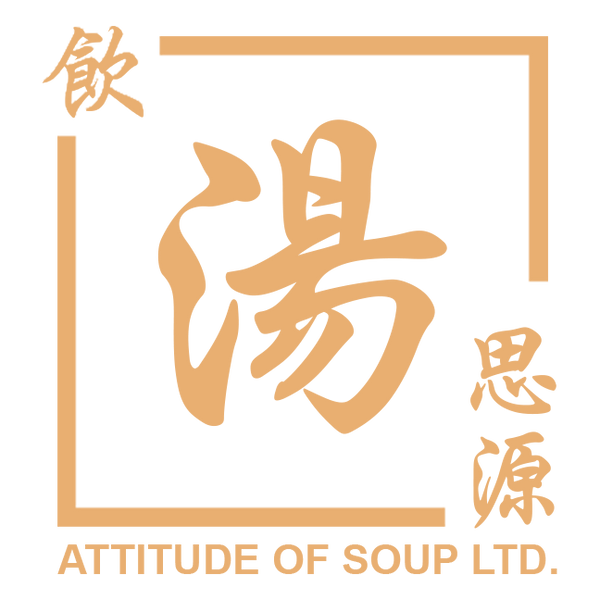GLOW | Radiant Warmth, Gentle Comfort
PREPARED POLYGONUM MULTIFLORUM ROOT, BLACK BEAN & CONCH SOUP
PREPARED POLYGONUM MULTIFLORUM ROOT, BLACK BEAN & CONCH SOUP
Couldn't load pickup availability
From now until Dec 26, every order receives a complimentary flower tea sample.
Rich & Aromatic · Gentle Warmth from Within
A deeply aromatic Hong Kong–style Chinese herbal soup mix made with prepared Polygonum Multiflorum Root (Fo-Ti (Processed) / He Shou Wu) (何首烏(製)), Black Beans (黑豆), and dried Conch Slices (螺片). The rich, smooth flavor blends earthy notes with a natural seafood sweetness, creating a comforting and balanced taste experience.
Crafted in Canada with premium dried ingredients, this easy-to-cook soup mix brings warmth and calm to your day — a cozy bowl that nourishes the senses and fills your home with gentle radiance.
Cooking Method:
Rinse ingredients lightly. Add about 1.2 L of water, bring to a boil, then simmer for around 2 hours. Season to taste. Suitable for stovetop, pressure cooker, or vacuum-insulated jar cooking.
This is a soup ingredient pack that lets you easily cook and enjoy authentic nourishing Chinese soup at home anytime!
Ingredients
Ingredients
Black Bean, Gorgon Fruit, Red Kidney Bean, Peanut, Prepared Polygonum Multiflorum Root (Fo-Ti (Processed)), Dried Conch Slice, Dried Chinese Yam, Cashew, Dried Jujube
Contains: Peanut, Tree Nuts (Cashew)
Suitable For
Suitable For
.Perfect for anyone who wants an easy way to enjoy authentic Hong Kong style Chinese soup at home whether you’re new to cooking, living a busy lifestyle, or simply looking for a cozy family meal.
.Suitable for consumption after pregnancy.
Method and Serving Size
Method and Serving Size
Simply rinse the ingredients, place them in a pot, and add water (recommended 1.2 liters). Bring it to a boil over high heat, then change to the lowest heat setting of the smallest stove and simmer for 2 hours. Using the recommended amount of water can yield two large bowls or four regular-sized servings of soup, suitable for a small family.
Other Cooking Methods
Other Cooking Methods
.Cooking Soup with an Instant Pot
Simply rinse the ingredients, place them in the Instant Pot, and add 1.2 liters of water. Set the pot to the Soup mode and cook for 1 hour. After releasing the pressure, you can switch to Sauté mode and simmer for an additional 15 minutes for a richer flavor. This amount of water will yield two large bowls or four regular-sized servings of soup, perfect for a small family.
.Steeping Soup in a Vacuum Insulated Food Jar
Simply rinse the ingredients, place them in a vacuum insulated food jar (recommended size: 750ml), and fill it with hot water. Let it steep for about 4 hours.
Optional Add-on
Optional Add-on
Since the soup is already flavored by the ingredients, there is no need to add additional meat or seasoning when cooking the soup. If you want the soup to be thicker, you can add: Blanched Black Silkie Chicken / Blanched Lean Meat
Storage and Best Before
Storage and Best Before
Please keep in a cool dry place or refrigerator. Avoid high temperature and humidity, or direct sunlight. Recommended to consume within 12 months.
Country of Origin and Packaging
Country of Origin and Packaging
British Columbia, Canada
- Vacuum-sealed: Safe, hygienic, easy to store
- Free shipping: $65+ (Greater Vancouver), $99+ (Canada-wide)
- Sending as a gift? Add a free personalized message card!
The amount of ingredients in the picture is for reference only, the actual amount will be adjusted according to the prepared soup recipe
Share



How to consume soup packet
Learn more about the key Chinese herbs and other traditional ingredients in this soup mix
What is Polygonum Multiflorum (Fo-Ti / He Shou Wu 何首烏)?
Polygonum Multiflorum, also known as Fo-Ti, is the dried tuber root of the plant Polygonum multiflorum Thunb., a traditional herbal ingredient commonly used in Hong Kong–style soups and home wellness recipes.
It has a spindle-shaped or irregular appearance, with a reddish-brown to dark brown outer surface and firm texture.
When sliced, it reveals a fibrous, radiating interior pattern and emits a light, slightly bitter herbal aroma.
After soaking or simmering, Fo-Ti releases a warm, mellow scent that adds rich depth and natural sweetness to the broth.
Characteristics
According to records in Traditional Chinese Medicine (TCM), Fo-Ti is bitter, sweet, and astringent in taste, and slightly warm in nature.
It has been traditionally described as supporting the liver and kidneys, nourishing the blood and vitality, and promoting overall strength and balance.*
When simmered, its earthy sweetness and smooth texture enhance the aroma and body of the soup, making it a beloved ingredient in Hong Kong–style nourishing and restorative soups.
Cooking and Pairing Suggestions
- Soup / Stew: Fo-Ti is often cooked with black beans, red dates, and black-bone chicken, creating a flavorful and aromatic broth that’s naturally rich and comforting — a popular choice for family wellness soups.
- Herbal Tea / Infusion: Combine Fo-Ti with mulberry mistletoe (Taxillus chinensis), lotus seeds, and eggs to make the traditional Fo-Ti, Mistletoe, and Lotus Seed Egg Tea, a soothing and mildly sweet tonic drink enjoyed for its smooth and gentle flavor.
Interesting to Know
Fo-Ti exists in two common forms — Raw Fo-Ti (Sheng Shou Wu) and Processed Fo-Ti (Zhi Shou Wu) — each with distinct preparation methods and uses:
- Raw Fo-Ti (生首烏): Naturally sun-dried without processing. It has a stronger, more bitter taste and is traditionally used for specific applications rather than daily consumption.
- Processed Fo-Ti (製首烏): Steamed with black bean juice or other ingredients before drying. It has a deeper color, softer texture, and milder flavor — commonly used in soups and wellness tonics.
In Hong Kong–style cooking, processed Fo-Ti is preferred for its smooth flavor and balanced warmth, making it ideal for regular home use.
*Source: Hong Kong Baptist University Chinese Medicinal Material Images Database. The above information is cited from traditional references and provided for general ingredient knowledge only.
What is Black Bean (Black Soybean) (黑豆)?
Black Bean, also known as Black Soybean (Glycine max), is a variety of soybean with a dark seed coat.
It is one of the most common legumes used in Hong Kong–style soups and home wellness cooking.
Recognized for its deep black or purplish-black color and glossy surface, black beans are firm in texture, aromatic, and rich in flavor.
When cooked, they release a warm bean fragrance with a subtle natural sweetness.
Due to their high plant-based protein content and hearty taste, black beans are often included in nourishing soup mixes, porridge, and herbal drinks enjoyed throughout the year.
Characteristics
Black beans have a rich, toasty aroma and a full, earthy flavor. When simmered slowly, they soften to a smooth texture while releasing a mild sweetness that deepens the overall taste of the soup.
They pair exceptionally well with meat, seafood, and root vegetables, balancing heaviness and adding natural depth to the broth.
Cooking and Pairing Suggestions
- Soup / Stew: Black beans are commonly simmered with dried tangerine peel, lotus seed, or lean pork, creating a fragrant and naturally sweet broth with a deep, comforting aroma.
- Porridge / Nourishing Meal: Cook black beans with red dates, rice, or pumpkin to make Black Bean Nourishing Congee — smooth, aromatic, and perfect for gentle everyday nourishment.
- Brewed Drink / Infusion: Black Bean Water (also known as Black Bean Tea) has become a popular and simple health drink in recent years. Rinse the beans, then simmer them over medium heat for about 30 minutes.
The result is a fragrant, lightly sweet beverage that’s smooth and refreshing — suitable for daily hydration.
Interesting to Know
In Chinese food culture, black beans are known as the “King of Beans.”
Ancient wisdom refers to the idea of “using black to nourish black” (“以黑養黑”), symbolizing balance and restoration.
Traditional belief associates black foods with grounding and nourishment.
Other commonly enjoyed black foods — such as black sesame, black fungus, and black rice — are also prized for their distinctive aroma and elegant color.
Together, these dark-hued ingredients embody the Eastern philosophy of “harmony in color and nourishment through food.”
*The above information is provided for general ingredient knowledge only.
What Is Kidney Bean (紅腰豆)?
Kidney Bean is a common type of legume and a variety of Phaseolus vulgaris L..
It gets its name from its kidney-like shape and deep red color. The beans are firm, plump, and smooth-skinned, ranging from bright red to dark wine red.
Kidney beans have a rich, hearty flavor and a creamy texture. When cooked, they release a mild bean aroma with a subtle natural sweetness. They are widely used in Hong Kong–style soups, sweet desserts, stews, and salads, making them a popular and versatile ingredient in home cooking.
Characteristics
Kidney beans have a rich, full-bodied flavor and a soft, creamy texture.
When simmered for a long time, they release a fragrant aroma and gentle sweetness, adding depth and smoothness to soups.
Compared to other beans, kidney beans have a thicker, creamier mouthfeel and a more intense taste.
In Hong Kong home cooking, they pair well with meats, tomatoes, root vegetables, and other hearty ingredients to create wholesome, flavorful dishes.
Cooking and Pairing Suggestions
- Soups / Stews: Kidney beans can be simmered with tomatoes, onions, carrots, or pork ribs to create a tangy and slightly sweet Tomato Kidney Bean Soup, known for its bright flavor and rich aroma.
- Desserts / Sweet Soups: They can also be cooked with coconut milk, red beans, or Job’s Tears to make a smooth and lightly sweet Kidney Bean Dessert Soup, a comforting option for cooler seasons.
- Salads / Baked Dishes: Cooked kidney beans can be chilled and added to salads or baked rice dishes, adding color, texture, and plant-based protein — a nutritious choice for balanced meals.
Interesting to Know
Although kidney beans and red beans (adzuki beans) share similar names, they are actually two different types of legumes.
- Kidney beans are larger, curved, and kidney-shaped with a glossy red skin and a dense, creamy texture — ideal for soups, stews, or baked dishes.
- Red beans are smaller, rounder, and naturally sweeter, commonly used in desserts such as red bean soup and glutinous rice balls.
Both varieties have a naturally sweet bean flavor, but kidney beans are better suited for savory soups and main dishes, while red beans are often used in festive and sweet desserts.
In Hong Kong home cooking, both are beloved for their flavor and versatility, bringing warmth, color, and nourishment to the dining table.
*The above information is provided for general ingredient knowledge only.
I really like the soup packs from Yum Tong See Yuen, in ample size and good quality of ingredients,. Especially this Fo-Ti black bean soup, with the benefits of beautifies the skin and nourishes the body from inside out.
Thank you so much for your lovely review! ❤️ We’re so happy to hear you’re enjoying our soup packs, especially the Fo-Ti Black Bean Soup. It’s one of our favourites too—nourishing, comforting, and packed with goodness for the hair and skin.
Thank you again for your support, and we look forward to serving you more warm bowls soon! 😊
I've been wanting to make some soup with 何首烏 but have been so lazy in buying all three ingredients. This soup is perfect and so easy to make!
Thank you so much for your kind words! We’re so glad you found our soup convenient! It’s great to hear that our hair care soup was exactly what you needed without the hassle of gathering all the ingredients. We hope it made your day easier and tastier! 😊
This soup was perfect for me as I’ve just given birth, it’s so easy to make and delicious!
Congratulations on your new arrival! Thank you for your wonderful review. We’re delighted to hear that our soup was perfect for you during this special time and that you found it easy and delicious to make.☺️ Wishing you and your family all the best, and we look forward to serving you again!
Why You'll Love This Soup Packet
-

NOURISHING & HEALTH-BOOSTING
Carefully blended Chinese herbal ingredients to support your wellness goals.
-

CONVENIENT & TIME-SAVING
Ready-to-cook packets with simple instructions—just add water & simmer!
-

SAFE, FRESH & HYGIENIC
Individually vacuum-sealed to lock in freshness.
-

PERFECTLY PORTIONED
Designed for small families (2 large bowls / 4 regular bowls) to prevent waste.








